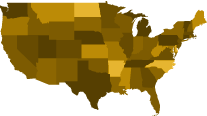Your Baby’s Screening What Happens to the Blood Sample
After the newborn screening tests are done, a small amount of dried blood remains on the filter paper card. Many labs keep and store these “residual samples” because of their continued value to the family, laboratories’ quality control and assurance monitoring, and public health.
Each state’s policies around residual blood spot storage and use are different – some store the blood samples only for a few weeks and then destroy them, while others store the spots indefinitely. For more information about your state’s policy, visit the conditions screened by state page or contact your state’s newborn screening program.
FAQ:
- Q: What uses do residual dried blood spots have for a family?
- A: Dried blood spots can be used in the event that a baby requires retesting, providing a fast alternative to bringing the parents and infant back to the hospital for a new blood draw. This is critical, as many of the conditions screened for by newborn screening need to be diagnosed as quickly as possible. Many states try to leave one full spot on the card.
The dried blood spots can also be made available to the parents for further health-related tests for their newborn, and can be used for identification purposes in the case of a missing or deceased child. The dried blood spots can be used to provide a match to help identify the child at the parent’s request.
- Q: How do residual dried blood spots help state public health programs?
- A: Residual dried blood spots are used in quality assurance and quality control procedures to ensure a laboratory’s equipment is working properly. The samples also aid in the development of new newborn screening tests that can be made available to improve the health outcomes of our nation’s newborns. Our current newborn screening system is built upon such practices.
- Q: How do residual dried blood spots help biomedical research?
- A: Public health programs utilize dried blood spots for population-based research. Furthermore, dried blood spots provide states with an unbiased, complete sample that allows states to better understand factors that contribute to the health of their residents, and to better address public health issues.
- Q: Where are residual dried blood spots stored?
- A: Typically, the same laboratory that conducted the newborn screening testing also manages the storage of dried blood spots. Storage facilities are located either at state public health laboratories, university and medical center laboratories, or private laboratories contracted by the state.
- Q: How do states protect the privacy of personally identifiable information?
- A: In all states, the primary concern of the dried blood spots storage program is security. In most states, once newborn screening is completed, the filter paper containing the residual dried blood spots is separated from the newborn screening card that contains the newborn’s identifying information. The residual dried blood spots sample is assigned a code and is stored in a locked facility accessible only by employees with extensive data privacy training. When the dried blood spots sample is used for research purposes, the sample is assigned yet another code or tracking number, which ensures that the research team is many steps removed from any identifying information. Additionally, all requests for the use of residual dried blood spots for research must be reviewed, at minimum, by an Institutional Review Board before the de-identified spots can be released for research. Exact procedures vary state-by-state, but the above practices are typical of those implemented in all states and territories practicing dried blood spots storage.
- Q: How long do states retain dried blood spots?
- A: Depending upon the state, dried blood spots can be retained anywhere from one month to indefinitely. Most states store residual dried blood spots for over one year.
- Q: Have residual dried blood spots ever been misused?
- A: To date, there have been no published reports on the misuse of residual dried blood spots. Privacy protections and patient confidentiality rules ensure that blood spots cannot be accessed by a third party, including insurers and law enforcement. Protecting the interests of the infants from whom the dried blood spots are obtained is of the utmost importance to state public health programs. States continue to develop guidelines for the persistent and expanded use of residual samples.
For more information on your state’s policy regarding dried blood spot storage, contact your state newborn screening program.
To learn more about the kinds of activities that may be conducted with residual newborn screening dried blood samples visit the Newborn Screening Translational Research Network’s website.
Ask an Expert
Have a question that’s not answered on Baby’s First Test? Send it to our experts.

